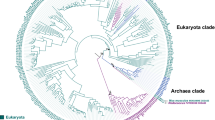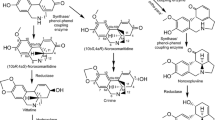Abstract
The existence of multiple, alternative pathways for polyamine biosynthesis, and the presence of alternative polyamine structural analogs, is an indication of the physiological importance of polyamines and their long evolutionary history. Polyamine biosynthesis is modular: diamines are synthesized directly or indirectly from amino acids, and triamines are synthesized from diamines by transfer of aminopropyl, carboxyaminopropyl, or aminobutyl groups to the diamine. Diversification of polyamine biosynthesis has depended on gene duplication and functional divergence, on gene fusion, and on horizontal gene transfer. Four examples of polyamine biosynthetic diversification are presented here with a discussion of methodological and conceptual approaches for identification of new pathways.
Access this chapter
Tax calculation will be finalised at checkout
Purchases are for personal use only
Similar content being viewed by others
References
Wallace HM, Fraser AV, Hughes A (2003) A perspective of polyamine metabolism. Biochem J 376:1–14
Bacchi CJ, Yarlett N (2002) Polyamine metabolism as chemotherapeutic target in protozoan parasites. Mini Rev Med Chem 2:553–563
Ivanov IP, Atkins JF, Michael AJ (2010) A profusion of upstream open reading frame mechanisms in polyamine-responsive translational regulation. Nucleic Acids Res 38:353–359
Pegg AE, Michael AJ (2010) Spermine synthase. Cell Mol Life Sci 67:113–121
Illingworth C, Mayer MJ, Elliott K, Hanfrey C, Walton NJ, Michael AJ (2003) The diverse bacterial origins of the Arabidopsis polyamine biosynthetic pathway. FEBS Lett 549:26–30
Adl SM, Simpson AG, Farmer MA, Andersen RA, Anderson OR, Barta JR, Bowser SS, Brugerolle G, Fensome RA, Fredericq S, James TY, Karpov S, Kugrens P, Krug J, Lane CE, Lewis LA, Lodge J, Lynn DH, Mann DG, McCourt RM, Mendoza L, Moestrup O, Mozley-Standridge SE, Nerad TA, Shearer CA, Smirnov AV, Spiegel FW, Taylor MF (2005) The new higher level classification of eukaryotes with emphasis on the taxonomy of protists. J Eukaryot Microbiol 52:399–451
Koonin EV, Wolf YI (2008) Genomics of bacteria and archaea: the emerging dynamic view of the prokaryotic world. Nucleic Acids Res 36:6688–6719
Fraser C, Alm EJ, Polz MF, Spratt BG, Hanage WP (2009) The bacterial species challenge: making sense of genetic and ecological diversity. Science 323:741–746
Chattopadhyay MK, Tabor CW, Tabor H (2009) Polyamines are not required for aerobic growth of Escherichia coli: preparation of a strain with deletions in all of the genes for polyamine biosynthesis. J Bacteriol 191:5549–5552
Momany C, Ernst S, Ghosh R, Chang NL, Hackert ML (1995) Crystallographic structure of a PLP-dependent ornithine decarboxylase from Lactobacillus 30a to 3.0 A resolution. J Mol Biol 252:643–655
Bell E, Malmberg RL (1990) Analysis of a cDNA encoding arginine decarboxylase from oat reveals similarity to the Escherichia coli arginine decarboxylase and evidence of protein processing. Mol Gen Genet 224:431–436
Andrell J, Hicks MG, Palmer T, Carpenter EP, Iwata S, Maher MJ (2009) Crystal structure of the acid-induced arginine decarboxylase from Escherichia coli: reversible decamer assembly controls enzyme activity. Biochemistry 48:3915–3927
Kashiwagi K, Watanabe R, Igarashi K (1994) Involvement of ribonuclease III in the enhancement of expression of the speF-potE operon encoding inducible ornithine decarboxylase and polyamine transport protein. Biochem Biophys Res Commun 200:591–597
Igarashi K, Kashiwagi K, Hamasaki H, Miura A, Kakegawa T, Hirose S, Matsuzaki S (1986) Formation of a compensatory polyamine by Escherichia coli polyamine-requiring mutants during growth in the absence of polyamines. J Bacteriol 166:128–134
Nagano T, Kikuchi Y, Kamio Y (2000) High expression of the second lysine decarboxylase gene, ldc, in Escherichia coli WC196 due to the recognition of the stop codon (TAG), at a position which corresponds to the 33th amino acid residue of sigma38, as a serine residue by the amber suppressor, supD. Biosci Biotechnol Biochem 64:2012–2017
Hamana K, Matsuzaki S (1992) Polyamines as a chemotaxonomic marker in bacterial systematics. Crit Rev Microbiol 18:261–283
Lee J, Michael AJ, Martynowski D, Goldsmith EJ, Phillips MA (2007) Phylogenetic diversity and the structural basis of substrate specificity in the beta/alpha-barrel fold basic amino acid decarboxylases. J Biol Chem 282:27115–27125
Takatsuka Y, Yamaguchi Y, Ono M, Kamio Y (2000) Gene cloning and molecular characterization of lysine decarboxylase from Selenomonas ruminantium delineate its evolutionary relationship to ornithine decarboxylases from eukaryotes. J Bacteriol 182:6732–6741
Altschul SF, Gish W, Miller W, Myers EW, Lipman DJ (1990) Basic local alignment search tool. J Mol Biol 215:403–410
Thompson JD, Higgins DG, Gibson TJ (1994) CLUSTAL W: improving the sensitivity of progressive multiple sequence alignment through sequence weighting, position-specific gap penalties and weight matrix choice. Nucleic Acids Res 22:4673–4680
Wilgenbusch JC, Swofford D (2003) Inferring evolutionary trees with PAUP*. Curr Protoc Bioinformatics, Chapter 6, Unit 6 4
Kumar S, Tamura K, Nei M (1994) MEGA: molecular evolutionary genetics analysis software for microcomputers. Comput Appl Biosci 10:189–191
Hall BG (2008) Phylogenetic trees made easy, 3rd edn. Sinauer Associates, Sunderland, MA
Page RD (1996) TreeView: an application to display phylogenetic trees on personal computers. Comput Appl Biosci 12:357–358
Lee J, Sperandio V, Frantz DE, Longgood J, Camilli A, Phillips MA, Michael AJ (2009) An Alternative Polyamine Biosynthetic Pathway is Widespread in Bacteria and Essential for Biofilm Formation in Vibrio Cholerae. J Biol Chem 284:9899–9907
Wu H, Min J, Zeng H, McCloskey DE, Ikeguchi Y, Loppnau P, Michael AJ, Pegg AE, Plotnikov AN (2008) Crystal structure of human spermine synthase. J Biol Chem 283:16135–16146
Pegg AE, Michael AJ (2009) Spermine synthase. Cell Mol Life Sci 67:113–121
Luo J, Fuell C, Parr A, Hill L, Bailey P, Elliott K, Fairhurst SA, Martin C, Michael AJ (2009) A novel polyamine acyltransferase responsible for the accumulation of spermidine conjugates in Arabidopsis seed. Plant Cell 21:318–333
Zimmermann P, Hirsch-Hofmann M, Hennig L, Gruissem W (2004) GENEVESTIGATOR. Arabidopsis microarray database and analysis toolbox. Plant Physiol 136:2621–2632
Grienenberger E, Besseau S, Geoffroy P, Debayle D, Heintz D, Lapierre C, Polllet B, Heitz T, Legrand M (2009) A BAHD acyltransferase is expressed in the tapetum of Arabidopsis anthers and is involved in the synthesis of hydroxycinnamoyl spermidines. Plant J 58:246–259
Author information
Authors and Affiliations
Editor information
Editors and Affiliations
Rights and permissions
Copyright information
© 2011 Springer Science+Business Media, LLC
About this protocol
Cite this protocol
Michael, A.J. (2011). Exploring Polyamine Biosynthetic Diversity Through Comparative and Functional Genomics. In: Pegg, A., Casero, Jr., R. (eds) Polyamines. Methods in Molecular Biology, vol 720. Humana Press. https://doi.org/10.1007/978-1-61779-034-8_2
Download citation
DOI: https://doi.org/10.1007/978-1-61779-034-8_2
Published:
Publisher Name: Humana Press
Print ISBN: 978-1-61779-033-1
Online ISBN: 978-1-61779-034-8
eBook Packages: Springer Protocols




